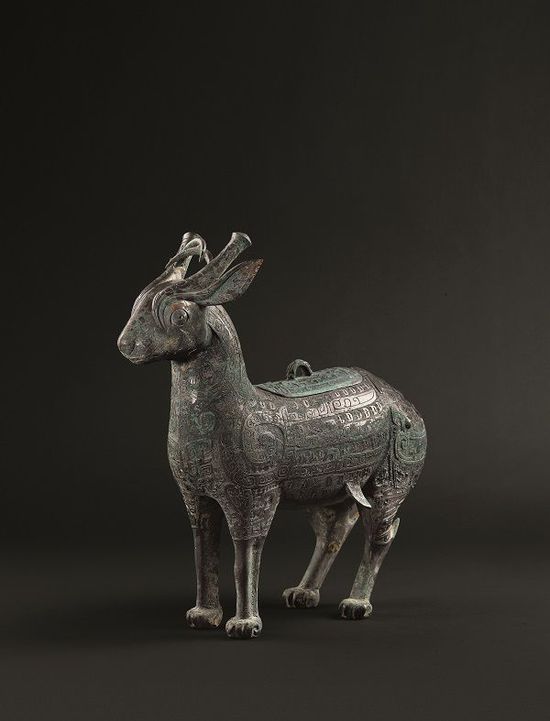The Age of Transition: Bronzes and Molds Found in Daijiawan, Shigushan, Baoji County, Shaanxi
- When:
- Monday, November 30, 2015 9:00 am - 6:00 pm
- Where:
-
All day
Begins November 30 through December 3, 2015
University of Chicago Center in Beijing & Baoji County, Shaanxi Province - Description:
-

About the Archaeological Discoveries in Daijiawan, Anyang, and Shigushan
The discovery of two large and unlooted tombs in Shigushan, Baoji in 2012 and 2013 immediately became the focus of scholarly attention and that of the general public as well. The site of Shigushan was enlisted as one of the ten most important archaeological discoveries in China in 2013, and is the subject of an exhibit in the Shanghai Museum that featured many of the spectacular bronzes from the Shigushan tombs, and bronzes from Daijiawan as well. The unexpected discovery has provided the missing archaeological contexts for the looted Daijiawan bronzes, and has brought afore issues related to the transition between the Shang and the Zhou dynasties, in particular the relationship between Anyang and the Baoji region.
Since the turn of the twentieth century, the Daijiawan-Shigushan region in Baoji, Shaanxi has yielded a large number of Late Shang/Early Western Zhou bronzes, most of which were either chance finds, or looted and sold to museums outside of China. The earliest example, now in the Metropolitan Museum, is a set of twelve bronze vessels and a large bronze table uncovered by the locals and later collected by Duan Fang in 1901. In the 1920s, a Shaanxi warlord, Dang Yukuen, looted a Bronze Age cemetery in Daijiawan. The bronzes were soon scattered to various museum collections outside of China, such as the Freer and Sackler Gallery and the San Francisco Museum of Asian Arts. Some of these Daijiawan bronzes are of high quality with distinctive decorations and vessel shapes that led many scholars to date these bronzes to Early Western Zhou.
In the year 2000, archaeologists excavating Anyang, the last capital of the Shang dynasty, uncovered the first bronze foundry site since the 1960s at Xiaomintun Locus Southeast. Among the large amount of foundry remains, researchers identified mold fragments used to cast bronzes that are similar or identical to the Daijiawan find. The Xiaomintun mold fragments therefore bespeak the possibility that the Baoji bronzes were made in Anyang, and that the Xiaomintun foundry may have continued operation and produced bronzes for a new clientele in the Western Zhou period.
The Shigushan find, with the preserved archaeological context and undisturbed artifact assemblages, has generated a corpus of data that bespeak the presence of a group of local elite residing in the Baoji region during Early Western Zhou. In 2012, local farmers in Shigushan uncovered a large tomb (M3) richly furnished with bronzes. Archaeologists moved in and salvaged the tomb while locating more burials in the surrounding area. A second richly furnished tomb (M4) was subsequently excavated in 2013. Bronzes from the two large Shigushan tombs consist of typical Western Zhou style bronzes and also bronzes similar or identical to those from Daijiawan and those represented by the Anyang molds. While the Shigushan excavations provide the long needed archaeological contexts for the Duan Fang and the Daijiawan bronzes, mold fragments from Anyang reveal connections between the Early Western Zhou and the Late Shang periods that have yet to be clearly understood. As many of the Baoji bronzes are inscribed, we can also begin to discuss the possible owners of the tombs and the bronzes, and to delineate interactions between the Baoji elite and their counterparts in Zhouyuan and beyond.
About the Conference
The conference was arranged under six topics:
Excavations at Shigushan
Compilation project of the Daijiawan Bronzes
Stylistic analysis of bronzes from Daijiawan and Shigushan
Epigraphic studies of the inscribed bronzes
Technological and metallurgical studies
Issues of dating and the historical and archaeological contexts of the Shigushan and Daijiawan bronzes and the Anyang mold fragments會議議程
11月30日 會議地點:芝加哥大學北京中心
9:20-10:00 主題演講
夏含夷(University of Chicago)
簡論芝加哥藝術博物館藏《師望鼎》的鑄造:試說文字在中國古代意識中的重要地位
10:00-12:00 小組發言
寶雞地區(一) 小組主持人 朱鳳瀚
10:00-10:40
劉軍社(寶雞市考古工作隊)
寶雞戴家灣·鬥雞台墓地的幾個問題
10:40-11:20
辛怡華(寶雞市考古工作隊)
戴家灣M16墓主與周公家族關係初探
11:20-12:00
丁岩(陝西省考古研究院)
石鼓山四號墓級別試探
DSC_1800
12:00-13:30 午餐
13:30-16:10 小組發言
寶雞地區(二) 小組主持人 王世民
13:30-14:10
張懋鎔(陝西師範大學歷史系)
關於戴家灣、石鼓山青銅尊、卣、禁的年代問題
14:10-14:50
陳昭容(中研院歷史語言研究所)
《寶雞戴家灣與石鼓山出土商周青銅器》編後拾零
14:50-15:30
張昌平(武漢大學歷史學院)
商周之際的鳳鳥紋卣——從石鼓山談起
15:30-16:10
張天恩(陝西省考古研究院)
石鼓山青銅器銘文鑄作工藝初識
16:10-16:50
常懷穎 (社科院考古研究所)
周初高等級貴族墓的葬樂與葬車:從石鼓山銅器群說起
16:50-17:30
董珊 (北京大學考古文博學院)
寶雞石鼓山與洛陽馬坡出土的臣辰銅器研究
17:30-18:00討論
18:30 晚宴
12月1日 會議地點:芝加哥大學北京中心
9:00-12:00 小組發言
安陽殷墟 小組主持人 李伯謙
9:00-9:40
李永迪(University of Chicago)
殷墟孝民屯東南地出土陶範與戴家灣石鼓山銅器群
9:40-10:20
內田純子(中研院歷史語言研究所)
孝民屯鑄銅遺址單位與陶範紋飾的分析
10:20-11:00
岳占偉(社科院考古研究所)
殷墟後期青銅器發展的兩個方向—兼論商式青銅器與周式青銅器的問題
11:00-11:40
牛世山(社科院考古研究所)
考古視野下的周人滅商–以殷墟的晚商與西周文化的變革為例
11:40-12:20
岳洪彬(社科院考古研究所)
商代「聚族而居、聚族而葬」的考古學觀察
DSC_1814
12:20-13:50 午餐
13:50-17:10 小組發言
商周之際 小組主持人 唐際根
13:50-14:30
黃銘崇(中研院歷史語言研究所)
殷墟末期的青銅器:從分器的角度探討
14:30-15:10
劉緒(北京大學考古文博學院)
商周之際族墓地簡論-以銅銘所見為主
15:10-15:50
雷興山(北京大學考古文博學院)
「一墓多族徽」與關中地區商周分界界標
15:50-16:30
李峰(Columbia University)
西周青銅器製作中的另類傳統
16:30-17:10
種建榮(陝西省考古研究院)
清澗辛莊鑄銅陶範的發現及相關問題思考
17:10-17:50
岳連建 (陝西省考古研究院)
商末周初青銅器的分期與斷代研究
17:50-18:20 討論
19:00 晚餐
12月2日 會議赴西安、寶雞
06:30 赴北京西
G653高鐵 始北京西 07:57-終西安北14:01
15:00 參觀陝西省考古院涇渭基地
16:30 赴寶雞
19:30入住寶雞萬福大酒店,用自助晚餐
12月3日 會議參觀寶雞戴家灣石鼓山及寶雞青銅器博物院
9:00 酒店出发
12月4日 會議地點:寶雞青銅器博物院
9:00-11:40 小組發言
青銅鑄造 小組主持人 王占奎
9:00-9:40
周亞(上海博物館)
寶雞出土青銅禁的觀察與分析
9:40-10:20
蘇榮譽(中科院自然科学史研究所)
關於扉梭的分鑄
10:20-11:00
廉海萍(上海博物館)
從鑄造工藝看石鼓山青銅器
11:00-11:40
任雪莉(寶雞青銅器博物院)
從石鼓山新出四耳青銅簋再論多耳鋬簋
11:40-12:30 圓桌討論
12:30 午宴
14:30 賦歸
